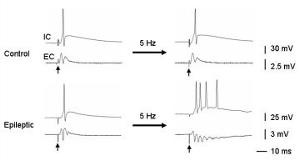PERFORANT PATH REPETITIVE STIMULATION AT 5 Hz INDUCES EPILEPTIFORM BURST ACTIVITY IN MINISLICES OF DENTATE GYRUS FROM RATS WITH KAINATE-INDUCED EPILEPSY
Abstract number :
2.095
Submission category :
Year :
2005
Submission ID :
5399
Source :
www.aesnet.org
Presentation date :
12/3/2005 12:00:00 AM
Published date :
Dec 2, 2005, 06:00 AM
Authors :
1,2Li-Rong Shao, and 1,2F. Edward Dudek
Several pathological changes in the epileptic brain have been hypothesized to lead to an enhanced propensity for seizure generation, but how spontaneous seizures occur is poorly understood. Many studies have used modified experimental conditions (e.g., suppression of inhibition and elevated extracellular [K+]) to compare seizure-like activity in brain slices from control and experimental animals. This study aimed to explore whether epileptiform activity could be selectively induced by repetitive stimulation under physiological conditions in rats with kainate-induced epilepsy. Dentate gyrus minislices of 450 [mu]m thickness were made from kainate- or saline-treated rats. Extracellular field-potential recordings (some with simultaneous whole-cell recordings) were obtained in the granule cell layer while lateral perforant path was electrically stimulated in artificial cerebrospinal fluid (aCSF). In control slices, single perforant path stimulations (100-500 [mu]A, 200 [mu]s) produced EPSPs with only a single population spike, and repetitive stimulations at different frequencies (1, 5, 10 Hz) did not cause a significant increase of the responses. In slices from kainate-treated rats, single perforant path stimulations caused either an EPSP with 1-2 population spikes or, in some slices, an EPSP followed by a 0.05-1 second-long negative shift with or without population spikes. For both types of responses, 5-Hz stimulation eventually transformed the responses into bursts with multiple population spikes (or in whole-cell recordings, depolarization with bursts of action potentials) in most slices. Repetitive stimulations at lower frequency (1 Hz) failed to produce this change, and higher frequencies (e.g., 10 Hz) were not as effective as 5 Hz. The results suggest that in isolated minislices of dentate gyrus from epileptic rats, repetitive synaptic stimulation at an appropriate frequency (i.e., 5 Hz) can significantly augment granule cell output under physiological conditions, which may facilitate the onset of seizure activity.[figure1] (Supported by NIH (NS 16683).)
